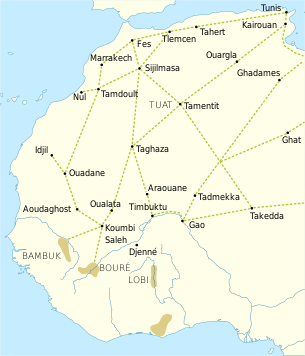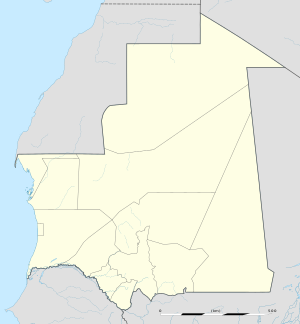Oualata
Oualata
Arabic:ولاتة | |
|---|---|
Communeand town | |
 View of the town looking in a southeasterly direction | |
| Coordinates:17°18′00″N7°01′30″W/ 17.3°N 7.025°W | |
| Country | Mauritania |
| Region | Hodh Ech Chargui |
| Population (2013 census)[1] | |
| • Total | 13,086 |
| Official name | Ancient Ksour of Ouadane, Chinguetti, Tichitt and Oualata |
| Type | Cultural |
| Criteria | iii, iv, v |
| Designated | 1996(20thsession) |
| Reference no. | 750 |
| Region | Arab States |

OualataorWalata(Arabic:ولاتة) (alsoBiruin 17th century chronicles)[2]is a small oasis town in southeastMauritania,located at the eastern end of theAoukarbasin. Oualata was important as acaravan cityin the thirteenth and fourteenth centuries as the southern terminus of atrans-Saharan traderoute and now it is aWorld Heritage Site.
History
[edit]The Oualata area is believed to have been first settled by an agro-pastoral people akin to theMandéSoninke peoplewho lived along the rocky promontories of the Tichitt-Oualata and Tagant cliffs of Mauritania facing theAoukarbasin. There, they built what are among the oldest stone settlements on the African continent.[3]
The town formed part of theGhana Empireand grew wealthy through trade. At the beginning of the thirteenth century Oualata replacedAoudaghostas the principal southern terminus of the trans-Saharan trade and developed into an important commercial and religious centre.[4]By the fourteenth century the city had become part of theMali Empire.
An important trans-Saharan route began atSijilmasaand passed throughTaghazawith its salt mines and ended at Oualata. The French historianRaymond Maunyestimated that in theMiddle Agesthe town would have accommodated between 2000 and 3000 inhabitants.[5]
Moroccan explorerIbn Battutafound the inhabitants of Oualata were Muslim and mainly Massufa, a section of theSanhaja.He was surprised by the great respect and independence that women enjoyed. He only gives a brief description of the town itself: "My stay at Iwalatan (Oualata) lasted about fifty days; and I was shown honour and entertained by its inhabitants. It is an excessively hot place, and boasts a few small date-palms, in the shade of which they sow watermelons. Its water comes from underground waterbeds at that point, and there is plenty of mutton to be had."[6]The town's originalMandenameBiruhad already shifted to the BerberIwalatan,a reflection of the changing identity of the residents. This would change again with the town's Arabization, and the development of the current name,Walata.[7]
From the second half of the fourteenth centuryTimbuktugradually replaced Oualata as the southern terminus of the trans-Sahara route and it declined in importance, becoming an increasingly poor backwater in comparison to the previous wealth of the town.[8][9]The Berber diplomat, traveller and authorLeo Africanusvisited the region in 1509–1510, and gives a description in his bookDescrittione dell’Africa:"Walata Kingdom: This is a small kingdom, and of mediocre condition compared to the other kingdoms of the blacks. In fact, the only inhabited places are three large villages and some huts spread about among the palm groves."[10]By that time, the composition of the kingdom seems to have changed to reflect a largeSonghai-speaking population residing within the town. "The language of this region is called Songhai, and the inhabitants are black people, and the most friendly unto strangers." Oualata was a tributary of theSonghai Empire;also reflected within Africanus' bookDescrittione dell’Africaexplaining "In my time this region was conquered by the king of Timbuktu and the prince of Oualata fled into the deserts, whereof the king granted him peace conditionally that he pay great yearly tribute and so the prince has remained tributary to the king of Timbuktu until this present."[11][12]
Description
[edit]The old town covers an area of about 600 m by 300 m, some of it now in ruins.[5]The sandstone buildings are coated withbancoand some are decorated with geometric designs. The mosque now lies on the eastern edge of the town but in earlier times may have been surrounded by other buildings. Oualata is home to amanuscriptmuseum,and is known for its highly decorativevernacular architecture.It was made a UNESCO World Heritage Site in 1996 together withOuadane,ChinguettiandTichitt.[13]
Gallery
[edit]-
Oualata Decorative Entrance
-
Oualata Mosque
-
Oualata Decorative Window
-
Oualata Decorative Secondary Entrance
-
Oualata Decorative Secondary Entrance
-
Oualata Decorative Main Entrance
-
View of Oualata 1
-
View of Oualata 2
-
View of Oualata 3
-
View of Oualata 4
See also
[edit]- Twelve Doors of the Mali Empire
- En attendant les hommes,2007 documentary film about women muralists in Oualata.
- Mauritania: Oualata, “the big sister of Timbuktu” documentary film onTV5MONDE Info,2023
References
[edit]- ^"Oualata (Agricultural Urban Commune, Mauritania) - Population Statistics, Charts, Map and Location".www.citypopulation.de.Retrieved2024-02-15.
- ^Hunwick 1999,p. 9 n4. Walata is the arabized form of the Mandingwalameaning a "shady place" while Biru is the Soninke word and has a similar meaning.
- ^Holl 2009.
- ^Levtzion 1973,p. 147.
- ^abMauny 1961,p. 485.
- ^Gibb 1929,p. 320.
- ^Cleaveland 2002,p. 37.
- ^Levtzion 1973,p. 80, 158.
- ^Mauny 1961,p. 432.
- ^Hunwick 1999,p. 275.
- ^Leo, Africanus (15 May 2017).The history and description of Africa and of the notable things therein contained.Taylor & Francis.ISBN978-1-317-02892-5.OCLC999621723.
- ^Today there is a deserted settlement called Tizert at a distance of 5 km from the town.
- ^"AncientKsourof Ouadane, Chinguetti, Tichitt and Oualata ".UNESCO: World Heritage Convention.Retrieved15 August2014.
Sources
[edit]- Cleaveland, Timothy (2002).Becoming Walata: A History of Saharan Social Formation and Transformation.Portsmouth, NH: Heinemann.ISBN978-0-325-07027-8.
- Gibb, H.A.R., ed. (1929).Ibn Battuta, Travels in Asia and Africa 1325-1354.London: Routledge.ISBN9788120608092.Extracts are availablehere.
- Holl, Augustin F.C. (2009)."Coping with uncertainty: Neolithic life in the Dhar Tichitt-Walata, Mauritania, (ca. 4000–2300 BP)".Comptes Rendus Geoscience.341(8–9): 703–712.Bibcode:2009CRGeo.341..703H.doi:10.1016/j.crte.2009.04.005.
- Hunwick, John O.(1999).Timbuktu and the Songhay Empire: Al-Sadi's Tarikh al-Sudan down to 1613 and other contemporary documents.Leiden: Brill.ISBN90-04-11207-3.
- Levtzion, Nehemia(1973).Ancient Ghana and Mali.London: Methuen.ISBN0-8419-0431-6.
- Mauny, Raymond (1961).Tableau géographique de l'ouest africain au moyen age, d'après les sources écrites, la tradition et l'archéologie(in French). Dakar: Institut français d'Afrique Noire.
Further reading
[edit]- Levtzion, Nehemia; Hopkins, John F.P., eds. (2000) [1981].Corpus of Early Arabic Sources for West Africa.New York, NY: Marcus Weiner Press.ISBN1-55876-241-8.
- Norris, H.T. (1993). "Mūrītāniyā".Encyclopaedia of Islam. Volume VII(2nd ed.). Leiden: Brill. p. 625.ISBN90-04-09419-9.
External links
[edit]- Map showing Oualata: Fond Typographique 1:200,000,République Islamique de Mauritanie Sheet NE-29-XI.











